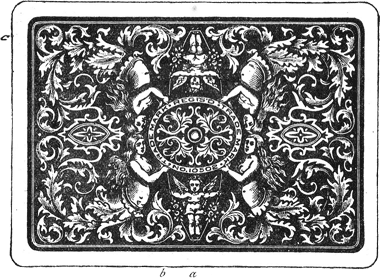
|
foreword to the online edition I. introductory II. common sharpers and their tricks III. marked cards and the manner of their employment IV. reflectors V. holdouts VI. manipulation VIII. the game of faro IX. prepared cards X. dice XI. high ball poker XII. roulette and allied games XIII. sporting houses XIV. sharps and flats
|
SHARPS AND FLATS
CHAPTER III MARKED CARDS AND THE MANNER OF THEIR EMPLOYMENT
§ E -- Shading and tint-markingManufactured cards having fallen into comparative desuetude, the reasonable inference is that they have been supplanted by something better; and such is the fact. In the hands of the best men they have been superseded by genuine cards, marked (generally by the sharp himself) either with 'shading' or 'line-work.' The earliest method of shading, so far as can be ascertained, consisted of the application to plain-backed cards of an even tint which, being rendered more or less deep, denoted the values of certain cards. This tint was produced by rubbing the card with a rag, lightly impregnated with plumbago, until the required depth of tint was obtained. This imperfect method, however, has gradually developed into others which can hardly be said to leave anything to be desired-at least from the sharp's point of view. At the present time shading is principally confined, if not entirely so, to ornamental backs. It is effected by applying a faint wash of color to a fairly large portion of the card. This color of course must be one which approximates to the tint of the card, and further, it must be one which will dry without removing the glaze. Just as there has been continual warfare between the makers of heavy guns and the inventors of armor-plating, so there has been a long struggle between the playing-card manufacturer and the professional gambler. Whilst the latter has been engaged in the endeavor to concoct a stain with which he could shade his cards without spoiling the enamel or altering the color, the former has done his best to circumvent the sharp's endeavors by compounding the glaze of ingredients which will spoil the 'little game.' For some time the manufacturer triumphed, and it became known that Hart's red 'Angel-backs' were unstainable. Alas! however, vice and, shall we say science was victorious, and one can now buy a fluid warranted to stain any card for a mere trifle. These fluids are nothing more than solutions in spirit of various aniline dyes. For red, aurosine is used, and for blue aniline blue. Stafford's red ink, diluted with spirit, produces a perfect stain for red cards. Others as good can be made with the 'Diamond' dyes. A suitable solution having been obtained, the cards are shaded, either by putting a wash over a certain spot or by washing over the whole of the back with the exception of one spot. The latter method is the better of the two in many respects, as the cards can be distinguished at a distance of two or three yards, and yet will bear the strictest examination, even at the hands of one who understands the former method. In fact, the closer one looks at the cards the less likely one is to discover the mark, or, as the sharp would say, to 'tumble' to the 'fake.' The directions for use issued with the shading fluids will be found on page 302. As the delicate tints of shaded work are lost in reproduction, satisfactory examples cannot be given. On the opposite page, however, will be found an illustration of one method of shading the familiar 'angel-hack' card represented in fig. 11. The shading in fig. It has been considerably exaggerated, to render it apparent. The little 'angel' (a, fig. 11) is made to indicate the value of the cards by shading the head for an ace; the right wing for a king; the left wing for a queen; the right arm for a knave, and so on. The two is not marked. FIG. 11 -- Angel-back The suit of the card is denoted by shading various pornons of the foliated design adjacent to the 'angel' (b, fig- 11).
FIG. 12 With the exception of the exaggerated shading, these marks are facsimiles of those upon a pack purchased from one of the dealers, all of whom supply them. Although the cards can be bought ready shaded, most sharpers prefer to do them for themselves. Therefore, they merely buy the marking- fluids, and invent their own marks.
|
| « marked cards... (...marked in manufacture) | marked cards... (line and scroll work) » |
home | introduction | book content | links | advertising | contact

